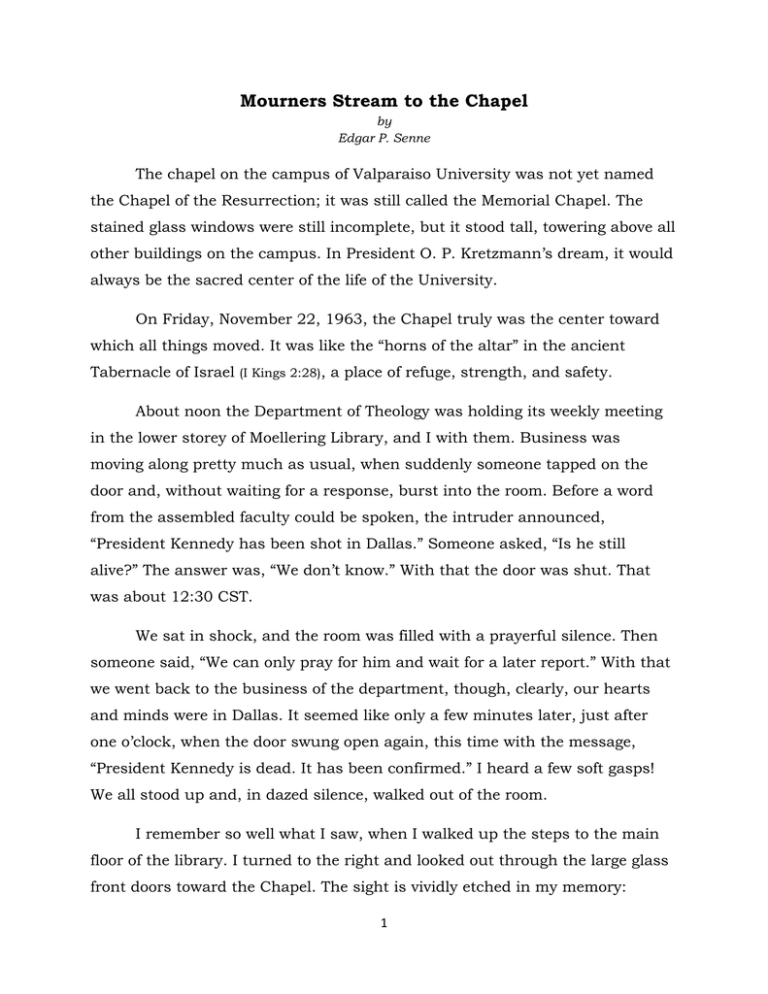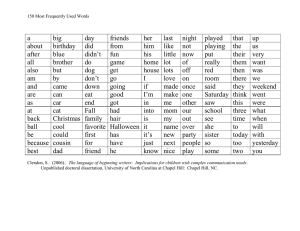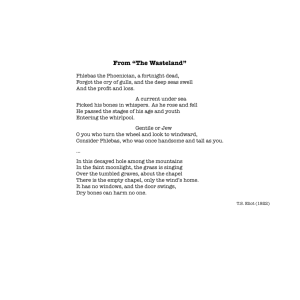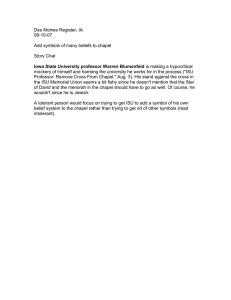Mourners Stream to the Chapel
advertisement

Mourners Stream to the Chapel by Edgar P. Senne The chapel on the campus of Valparaiso University was not yet named the Chapel of the Resurrection; it was still called the Memorial Chapel. The stained glass windows were still incomplete, but it stood tall, towering above all other buildings on the campus. In President O. P. Kretzmann’s dream, it would always be the sacred center of the life of the University. On Friday, November 22, 1963, the Chapel truly was the center toward which all things moved. It was like the “horns of the altar” in the ancient Tabernacle of Israel (I Kings 2:28), a place of refuge, strength, and safety. About noon the Department of Theology was holding its weekly meeting in the lower storey of Moellering Library, and I with them. Business was moving along pretty much as usual, when suddenly someone tapped on the door and, without waiting for a response, burst into the room. Before a word from the assembled faculty could be spoken, the intruder announced, “President Kennedy has been shot in Dallas.” Someone asked, “Is he still alive?” The answer was, “We don’t know.” With that the door was shut. That was about 12:30 CST. We sat in shock, and the room was filled with a prayerful silence. Then someone said, “We can only pray for him and wait for a later report.” With that we went back to the business of the department, though, clearly, our hearts and minds were in Dallas. It seemed like only a few minutes later, just after one o’clock, when the door swung open again, this time with the message, “President Kennedy is dead. It has been confirmed.” I heard a few soft gasps! We all stood up and, in dazed silence, walked out of the room. I remember so well what I saw, when I walked up the steps to the main floor of the library. I turned to the right and looked out through the large glass front doors toward the Chapel. The sight is vividly etched in my memory: 1 hundreds of students, faculty, and staff, streaming like a river along the walkway that leads into the Chapel. Was there a scheduled service? No, but several thousand hearts were calling for a time of worship and prayer. The crowd flooded into that house of prayer and filled it with their grief. Of course! What else could they do? Shocked! Frightened for our country! Vaguely frightened for themselves! Hearts full of grief and confusion! Their beloved young President, the one who had raised the level of hope in so many Americans; he’s gone, gone in an instant. What now? Like Joab fleeing to the horns of the altar in the ancient Tabernacle, the crowds were gravitating toward the Chapel, the present-day symbol of God’s presence. Someone, I don’t know who, ran to the home of President O. P. Kretzmann on the edge of the campus, informing him, “The Chapel is full, seats are filled, people are standing all around against the walls and milling around in the narthex. Please, will you come over and pray with us.” Dr. Kretzmann was only a few years from his retirement in 1968 and not very quick on his feet. Nevertheless, he picked up his prayer book, got into a car, and started the short drive up the little hill to the Chapel. He walked slowly down a side aisle, sat down on a front pew to catch his breath, then climbed the stairs into the chancel, taking his place behind the lectern. His voice was choked with grief, as he spoke, ever so briefly, about our shock, our fears, and our need to turn to the One who is our refuge and strength. He read Psalm 46, which begins, “God is our Refuge and Strength, a very present help in trouble.” Finally, he offered a few brief prayers and invited all to return at 6:30 that evening for a memorial service. As the President left the chancel, the people remained at their seats, many kneeling in silent prayer, some weeping audibly. At least 2,500 people gathered spontaneously that afternoon and another 3,000 that evening.* Dr. Kretzmann addressed the evening assembly, calling this event the culmination of “the horrifying and terrifying evil in the human soul. In an event like this,” he said, “God calls upon mankind to turn in repentance away from every form of hatemongering.” After his remarks, the 2 President led the community in praying the Litany, the Church’s traditional prayer of repentance and supplication. When vespers ended, not a person moved until the last candle was extinguished. Gradually, the crowd began to file out as silently as they had come. The Monday following President Kennedy’s assassination was declared a national day of mourning. Classes were cancelled and another memorial service was held in the Chapel. Dr. Richard Scheimann delivered the homily, focusing on the fact that God does not intervene against such evil actions as we are facing in this presidential assassination. He does not compel people to act in goodness and kindness; instead, he has chosen “to win us by the persuasion of love. God’s love challenges us, ‘Love your enemies and pray for those who persecute you, so that you may be children of your Father in heaven’” (Mt.5:4445). In this one dreadful and heart-rending event, the Chapel, as President Kretzmann had dreamed, was the sacred center of the campus, a harbor of safety and strength for a grieving community. Three times in these dark and somber days the Chapel was filled with people, yearning for the comfort of God’s Presence and some way to make sense of what we and the whole nation were experiencing. *To prompt my memory of some of the factual material in this story, I have consulted the Special Edition of The Torch, Saturday, November 23, 1963 and the next regular issue, published on November 27th. September 2009 3



